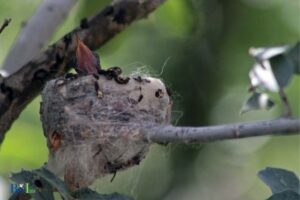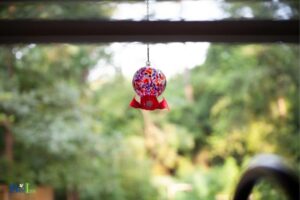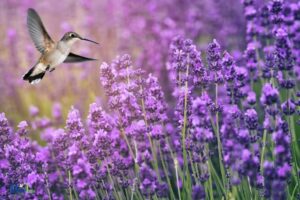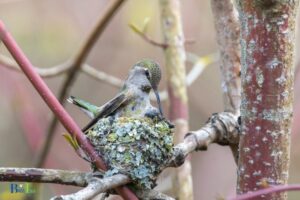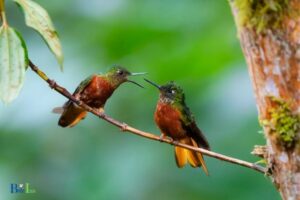How Tall Does Hummingbird Mint Get? 2 to 6 feet
Hummingbird mint, also known as Agastache, can grow to a height of 2 to 6 feet, depending on the specific variety.
Hummingbird mint is a perennial herbaceous plant that is native to North America. It is known for its tubular flowers that attract hummingbirds, butterflies, and other pollinators. The plant is also valued for its fragrant foliage, which has a strong, minty aroma.
The height of the plant can vary significantly depending on the specific species and growing conditions. However, the average height range for most varieties is between 2 and 6 feet.
Hummingbird mint is a versatile and visually appealing addition to any garden. Its vibrant, tubular flowers are not only attractive to pollinators but also add a pop of color to garden beds and borders.
When planting hummingbird mint, ensure it is placed in an area with well-drained soil and full sun exposure.
Providing these ideal conditions will encourage the plant to grow vigorously and reach its full height potential. Regular deadheading will also promote continuous blooming throughout the growing season.
Different Species Of Hummingbird Mint and Their Height Range
| Species | Common Name | Height Range |
|---|---|---|
| Agastache aurantiaca | Orange Hummingbird Mint | 24-36 inches (60-90 cm) |
| Agastache cana | Raspberry Hummingbird Mint | 24-36 inches (60-90 cm) |
| Agastache foeniculum | Anise Hyssop | 24-48 inches (60-120 cm) |
| Agastache mexicana | Mexican Giant Hyssop | 18-24 inches (45-60 cm) |
| Agastache pallidiflora | Pink Hummingbird Mint | 24-48 inches (60-120 cm) |
| Agastache rugosa | Korean Mint | 24-48 inches (60-120 cm) |
| Agastache scrophulariifolia | Purple Giant Hyssop | 36-60 inches (90-150 cm) |
Key Takeaway

Five Fascinating Facts about Hummingbird Mint’s Height
Understanding The Basics Of Hummingbird Mint
Hummingbird mint, also known as agastache, is a herbaceous perennial plant that belongs to the mint family.
This plant is known for its tubular, brightly colored flowers that attract hummingbirds and butterflies.
In this section, we’ll give you a brief overview of the benefits and characteristics of hummingbird mint.
What Is Hummingbird Mint, And What Are Its Characteristics?
Hummingbird mint is a plant that grows up to 3-4 feet tall and 1-2 feet wide. It has aromatic leaves that emit a minty scent when crushed, and it produces spikes of vibrant flowers that bloom from mid-summer to early fall.
Here are some key characteristics of hummingbird mint:
- It thrives in well-draining soil with full sun exposure.
- It’s drought tolerant, making it a low-maintenance plant.
- It’s easy to propagate through cuttings in the spring.
- It attracts pollinators such as hummingbirds, bees, and butterflies to your garden.
Benefits Of Hummingbird Mint
Hummingbird mint has many benefits beyond its aesthetic appeal.
Here are a few reasons why you should consider incorporating this plant into your garden:
- It attracts pollinators, which can improve overall garden health.
- It’s deer-resistant, making it a great choice for gardens in areas with high deer populations.
- It can be used in herbal teas and recipes as a flavoring agent.
- Its leaves can be used in aromatherapy due to its minty scent.
Hummingbird mint is a beautiful and beneficial plant that can add color and vibrancy to your garden. Plus, it’s low-maintenance and can attract a variety of pollinators.
How Tall Does Hummingbird Mint Get: The Ultimate Guide
The Factors Affecting The Height Of Hummingbird Mint
Hummingbird mint, also known as agastache, is a beautiful plant that is popular among gardeners because of its showy flowers that attract hummingbirds, bees, and butterflies.
The height of hummingbird mint largely depends on several factors, including:
- Species: Different species of hummingbird mint have different average heights. Some species can grow up to five feet tall while others are much shorter.
- Growing conditions: The growing conditions such as light, moisture, and soil quality can affect the height of the plant.
- Pruning: Regular pruning encourages branching and results in a bushier plant, which can affect the height of the plant.
- Fertilizer: The frequency and amount of fertilization can affect the growth rate and height of the plant.
The Average Height Range Of Different Species Of Hummingbird Mint
Hummingbird mint is a genus that comprises more than 40 species, each with a unique set of characteristics, including height.
Here is a list of the average height range of some of the most popular species of hummingbird mint:
- Agastache acapulco orange: 24-28 inches
- Agastache ava: 12-18 inches
- Agastache blue boa: 24-36 inches
- Agastache coronado red: Up to 18 inches
- Agastache kudos gold: 16-20 inches
- Agastache mint monarch: Up to 16 inches
The Tallest And Shortest Varieties Of Hummingbird Mint
If you’re looking to add some height variation to your garden, here are some of the tallest and shortest species of hummingbird mint:
- Tallest: Agastache rupestris can grow up to five feet tall.
- Shortest: Agastache rugosa ‘golden jubilee’ grows to be just 12-15 inches tall.
The Ideal Growing Conditions To Achieve Optimum Height
To achieve the optimum height of your hummingbird mint, there are a few growing conditions to consider:
- Light: Hummingbird mint thrives in full sun. It needs at least six hours of direct sunlight each day to grow healthy and tall.
- Soil: Well-draining soil is essential for hummingbird mint to grow tall. The plant prefers slightly acidic soil that is rich in organic matter.
- Watering: Regular watering is necessary for hummingbird mint to reach its full height potential. The plant requires about an inch of water each week.
- Pruning: Regular pruning encourages branching and results in a bushier plant. For the best results, prune your hummingbird mint in early summer before it flowers.
- Fertilizing: Monthly fertilization with a balanced fertilizer that is higher in phosphorous (p) than nitrogen (n) can promote strong root growth and encourage your hummingbird mint to grow tall.
Achieving a tall and healthy hummingbird mint requires a combination of ideal growing conditions and proper care. When planted and maintained correctly, the plant can add vibrant color and beauty to any garden.
Creating A Healthy And Beautiful Hummingbird Mint Garden
How Tall Does Hummingbird Mint Get: Creating A Healthy And Beautiful Hummingbird Mint Garden
Hummingbird mint, a perennial herb also known as agastache, is a popular choice for gardeners looking to attract hummingbirds and other pollinators to their garden.
Not only does it provide a beautiful display of flowers, but it also has a sweet scent that can fill up your garden with its aroma.
Here are some tips on how to create a healthy and beautiful hummingbird mint garden.
The Best Time To Plant Hummingbird Mint
Hummingbird mint can be planted in both spring and fall. However, it is best to plant it in the fall if you live in an area with hot summers.
Planting in the fall gives the roots enough time to establish before the hot season, and it will be ready to bloom in the following spring.
How To Plant And Care For Hummingbird Mint For Optimum Growth And Development
To have a flourishing hummingbird mint garden, it is essential to follow proper planting and care instructions.
Here are some tips on how to plant and care for hummingbird mint:
- Choose a spot that receives full sun or partial shade. Hummingbird mint prefers well-draining soil with a ph range of 6.5 to 7.5.
- Dig a hole twice the size of the pot and loosen the soil around the plant to encourage roots to spread.
- Water the plant frequently, especially during the first weeks, to help the roots establish. Hummingbird mint needs moderate watering, and the soil should dry out slightly between waterings.
- Add a layer of mulch around the plant to keep the soil moist and prevent weed growth.
- During the growing season, apply slow-release fertilizer or a balanced fertilizer every two months to promote growth and flowering.
Maintenance Tips For Keeping Hummingbird Mint Healthy And Thriving
Hummingbird mint is a low-maintenance plant, but it still needs proper care to remain healthy and thriving.
Here are some maintenance tips to follow:
- Deadhead the spent flowers to encourage more blooming.
- Remove diseased or damaged leaves and stems.
- Divide the plant every three to four years to maintain its size and health.
- Cut the plant back in the fall after it has stopped blooming to protect it from frost damage.
- It’s not necessary to prune hummingbird mint, but if you prefer a more compact plant, you can trim it back by one-third each spring.
Effective Pest Control Methods For A Healthy Hummingbird Mint Garden
Hummingbird mint is generally resistant to pests and diseases, but it can still be susceptible to some issues.
Here are some effective pest control methods to keep your hummingbird mint garden healthy:
- Plant hummingbird mint alongside companion plants such as marigold, lavender, and yarrow, which can repel pests.
- Treat any pest infestations early on with insecticidal soap or neem oil.
- Avoid over-fertilizing, as it can lead to spider mites and aphids.
- Keep an eye out for powdery mildew and remove any affected leaves immediately.
By following these tips, you can create a healthy and beautiful hummingbird mint garden that will brighten up your yard and attract pollinators.
The Ecological Significance Of Hummingbird Mint
Hummingbird mint, also known as agastache, is a fragrant, herbaceous plant that belongs to the mint family. It’s a favorite among gardeners because of its vibrant colors and ability to attract wildlife.
In this section, we will discuss the ecological significance of hummingbird mint, its role in pollination and ecological conservation, its impact on butterfly and bird populations, and how to conserve it for a sustainable ecosystem.
The Role Of Hummingbird Mint In Pollination And Ecological Conservation
Hummingbird mint is valued for its ability to attract pollinators to the garden, as it produces high concentrations of nectar.
When bees and hummingbirds visit a plant, they transfer pollen from the male to female flowers, which leads to fertilization and the production of seeds.
Here are some of the key points to note:
- Hummingbird mint’s tubular-shaped flowers attract hummingbirds, which are the main pollinators of the plant.
- Bees, butterflies, moths, and other pollinators are also attracted to the plant’s flowers.
- Hummingbird mint’s role in pollination helps maintain the ecological balance of the garden and supports biodiversity.
Impact Of Hummingbird Mint On Butterfly And Bird Populations
Hummingbird mint provides an essential source of food for butterflies and birds. The plants give butterfly larvae a place to lay their eggs and support the growth of caterpillars.
Here are some key points about its impact:
- Butterflies, such as the monarch, black swallowtail, and fritillary, lay their eggs on the plant’s leaves, and their larvae feed on the leaves and flowers.
- Hummingbird mint’s high nectar content attracts a wide variety of birds, including hummingbirds and sparrows, that feed on its flowers.
- As hummingbird mint provides a vital food source for butterflies and birds, their populations are influenced by the availability of these plants.
Conserving Hummingbird Mint For A Sustainable Ecosystem
Conserving hummingbird mint is essential to maintain a thriving and sustainable ecosystem.
Here are some key points to note:
- Hummingbird mint is a low-maintenance plant that’s easy to grow and propagate, making it an ideal plant for home gardeners.
- Growing hummingbird mint in your garden provides essential food and habitat for pollinators and supports biodiversity.
- Protecting and conserving hummingbird mint in the wild helps support the plant’s natural range and ensures its continued existence.
- Practices such as avoiding chemical pesticides and maintaining a diverse garden ecosystem can support the growth and conservation of hummingbird mint.
Exploring The Various Uses Of Hummingbird Mint
Hummingbird mint, also known as agastache, is a plant that is popular among gardeners because of its beautiful flowers and the ability to attract hummingbirds. However, this plant has more than just aesthetic value.
Here are some of the uses of hummingbird mint:
Culinary Uses Of Hummingbird Mint In Recipes And Beverages
Hummingbird mint has a unique flavor that adds an interesting twist to culinary creations.
Here are some ways to use hummingbird mint in recipes and beverages:
- Add the leaves to salads for a fresh, minty taste.
- Use the leaves to make tea or add them to lemonade for a refreshing drink.
- Chop the leaves and sprinkle them over grilled vegetables or meat.
- Use the flowers to garnish desserts like cakes, cupcakes, and fruit salads.
Medicinal Properties And Benefits Of Hummingbird Mint
Hummingbird mint has been used for centuries for its medicinal properties.
Here are some of its benefits:
- It contains antioxidants that protect against cell damage and diseases.
- It has anti-inflammatory properties that can reduce swelling and pain.
- It can help to promote relaxation and reduce stress.
- It is used in traditional medicine to treat digestive problems like bloating, gas, and indigestion.
Cultural Significance And Traditional Uses Of Hummingbird Mint
Hummingbird mint has cultural significance in different parts of the world.
Here are some traditional uses:
- Native americans used it for medicinal purposes, as well as in smudging ceremonies to purify and cleanse the air.
- In chinese medicine, the plant is used to treat coughs and colds.
- In mexico, it is brewed into a tea and used to treat respiratory problems.
Creative And Artistic Ways To Use Hummingbird Mint In Home Decor
Hummingbird mint can be used to add a touch of natural beauty to your home.
Here are some creative and artistic ways to use it in home decor:
- Place a vase with freshly cut hummingbird mint on a table or a windowsill for a pop of color and fragrance.
- Dry the leaves and flowers and use them to make potpourri or sachets.
- Add the leaves and flowers to your homemade candles for a unique scent.
- Press the leaves and flowers and use them to create beautiful art pieces or bookmarks.
Hummingbird mint has numerous uses aside from attracting hummingbirds to your garden. With its unique flavor, medicinal benefits, cultural significance, and versatility in home decor, this plant is worth considering for your next gardening project.
FAQ On Hummingbird Mint
How Tall Does Hummingbird Mint Get?
How Do I Care For Hummingbird Mint?
What Are Some Hummingbird Mint Varieties?
What Are The Benefits Of Growing Hummingbird Mint?
Can Hummingbird Mint Grow In Containers?
Conclusion
Hummingbird mint is an excellent addition to any garden, adding a burst of color and attracting pollinators such as hummingbirds and butterflies. From its bright flowers to its fragrant leaves, this plant is sure to captivate any gardener.
While the size of the plant may vary depending on the species and growing conditions, hummingbird mint can generally grow to be between 18 and 36 inches tall.
With its low maintenance requirements and ability to thrive in a range of climates, this plant is an ideal choice for gardeners of all skill levels. As with any plant, providing proper care, including regular watering and fertilization, can help it to reach its full potential.
With its striking appearance and numerous benefits, it is no wonder that hummingbird mint has become a favorite among gardeners. Now that you know how tall hummingbird mint can grow, it’s time to get planting and enjoy this beautiful addition to your garden.


